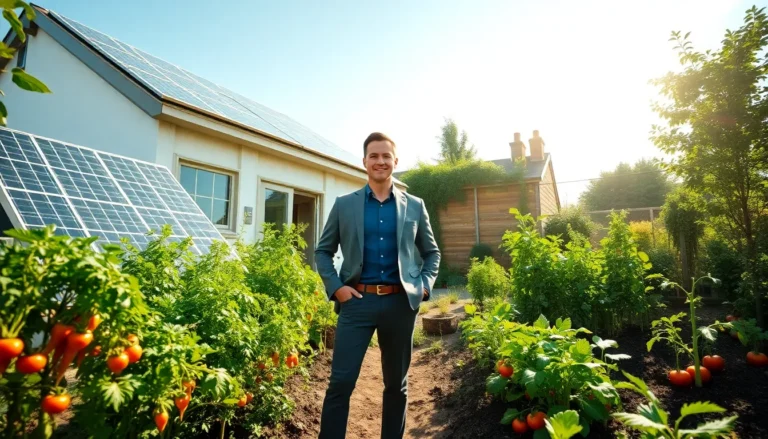Imagine a place where your morning coffee comes from local beans, your neighbors are as passionate about the environment as you are, and you can stroll through lush green spaces without worrying about smog. Welcome to the world of sustainable living communities. These innovative havens aren’t just about recycling and solar panels, they’re vibrant ecosystems designed to promote social interaction, environmental stewardship, and a lifestyle that feels good, inside and out. Curious about how these communities work and how you can join the trend? Keep reading.
Table of Contents
ToggleWhat Are Sustainable Living Communities?

Sustainable living communities are intentional communities designed to minimize their ecological footprint while enhancing the quality of life for their residents. Think of them as eco-friendly neighborhoods that prioritize sustainability, resilience, and community engagement. They often feature shared resources, communal spaces, and practices that support environmentally mindful living. Imagine living in a neighborhood where everyone pitches in to maintain gardens, share tools, or host workshops on sustainable practices, living in a supportive community feels completely different than being isolated in a typical urban sprawl.
Benefits of Sustainable Living Communities
The benefits of sustainable living communities extend far beyond the obvious environmental impact. Here are several key advantages:
- Stronger Community Bonds: Residents actively engage with one another, forging deep connections that provide not just support but a sense of belonging.
- Reduced Ecological Footprint: By utilizing renewable resources, minimizing waste, and promoting organic gardening, these communities significantly decrease their impact on the planet.
- Improved Health and Well-Being: Access to green spaces and fresh produce encourages a healthier lifestyle, leading to improved physical and mental well-being.
- Cost Savings: Shared resources can lead to lower living costs. Imagine splitting the cost of solar panels or a community garden.
- Education and Awareness: Residents become more informed about sustainable practices, which they can then pass on to their children and broader communities.
Key Features of Sustainable Living Communities
So, what exactly makes a community sustainable? Here are some standout features:
- Energy Efficiency: Many communities harness renewable energy sources like solar and wind to power their homes, minimizing dependence on non-renewable resources.
- Water Conservation: Rainwater harvesting systems and greywater recycling promote effective water usage, essential in a world increasingly aware of water scarcity.
- Shared Spaces: Communal gardens, tool libraries, and collective spaces for events encourage social interaction and a sense of togetherness.
- Local Food Systems: Community-supported agriculture (CSA) allows residents to buy directly from local farmers, boosting the local economy and ensuring fresher food.
- Sustainable Transport Options: These neighborhoods often prioritize walking and biking paths, reducing car dependency and promoting healthier lifestyles.
Examples of Successful Sustainable Living Communities
Around the world, exciting examples of sustainable living communities exist, illustrating various models:
- The EcoVillage in Ithaca, New York: This community focuses on ecological sustainability and social responsibility, featuring a residential area that incorporates permaculture and renewable energy.
- Christiana in Denmark: An autonomous neighborhood with a focus on eco-living, it is known for its communal spaces and artsy vibe, emphasizing sustainable practices in everyday life.
- Ecotopia in California: This experimental community integrates nature with sustainable living and provides educational workshops to share knowledge with outsiders.
- The Community of Tamera in Portugal: A research village that strives to create a model for future communities, emphasizing healing the planet and oneself through cooperation and shared knowledge.
Challenges Faced by Sustainable Living Communities
While sustainable living communities promote numerous benefits, they face unique challenges, including:
- Funding and Resources: Securing initial funding can be a hurdle, given that many members rely on collective resources and cooperative economics.
- Conflict Resolution: With tight-knit communities often come conflicts. Disagreements about community decisions or resource allocation might arise.
- Sustainability vs. Individual Needs: Balancing collective goals with individual preferences can prove tricky, especially when personal beliefs vary.
- Regulatory Hurdles: Zoning laws or building codes can complicate eco-building plans, potentially stalling development.
How to Get Involved in Sustainable Living Communities
Are you itching to jump into the sustainable living scene? Here’s how you can get involved:
- Research: Explore local sustainable communities to find one that resonates with your values and lifestyle. Many are open to new members and volunteers.
- Attend Events: Participate in workshops, community events, or information sessions to meet residents and learn about their practices.
- Volunteer: Many communities welcome volunteers to help with gardening, building, or organizing events. It’s a great way to immerse yourself in the culture.
- Connect: Use social media platforms to connect with sustainable living enthusiasts. Online resources like forums or websites dedicated to eco-living can lead to exciting opportunities.
The Future of Sustainable Living Communities
Looking ahead, the future of sustainable living communities seems promising. As awareness about climate change and environmental sustainability grows, more communities are likely to adopt these eco-friendly principles. Innovations in technology will continue to play a vital role, leading to more efficient energy and water systems. Also, as societal values shift towards community-oriented living, the demand for shared resources and cooperative economies will increase.
These changes resonate with a younger generation seeking fulfillment beyond material possessions. The growth of telecommuting also means individuals can consider living in these communities, as they’re no longer tethered to urban centers.



